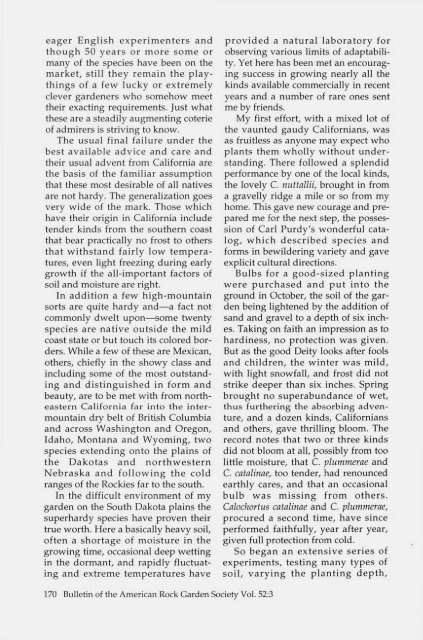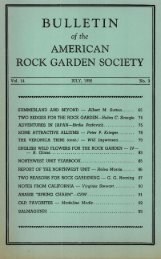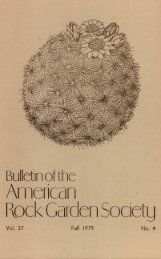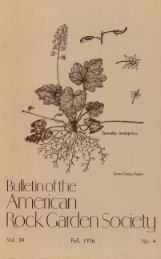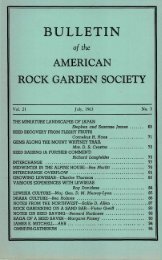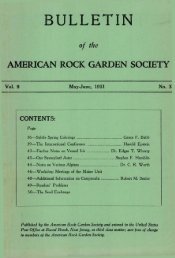Bulletin - Summer 1994 - North American Rock Garden Society
Bulletin - Summer 1994 - North American Rock Garden Society
Bulletin - Summer 1994 - North American Rock Garden Society
You also want an ePaper? Increase the reach of your titles
YUMPU automatically turns print PDFs into web optimized ePapers that Google loves.
eager English experimenters andthough 50 years or more some ormany of the species have been on themarket, still they remain the playthingsof a few lucky or extremelyclever gardeners who somehow meettheir exacting requirements. Just whatthese are a steadily augmenting coterieof admirers is striving to know.The usual final failure under thebest available advice and care andtheir usual advent from California arethe basis of the familiar assumptionthat these most desirable of all nativesare not hardy. The generalization goesvery wide of the mark. Those whichhave their origin in California includetender kinds from the southern coastthat bear practically no frost to othersthat withstand fairly low temperatures,even light freezing during earlygrowth if the all-important factors ofsoil and moisture are right.In addition a few high-mountainsorts are quite hardy and—a fact notcommonly dwelt upon—some twentyspecies are native outside the mildcoast state or but touch its colored borders.While a few of these are Mexican,others, chiefly in the showy class andincluding some of the most outstandingand distinguished in form andbeauty, are to be met with from northeasternCalifornia far into the intermountaindry belt of British Columbiaand across Washington and Oregon,Idaho, Montana and Wyoming, twospecies extending onto the plains ofthe Dakotas and northwesternNebraska and following the coldranges of the <strong>Rock</strong>ies far to the south.In the difficult environment of mygarden on the South Dakota plains thesuperhardy species have proven theirtrue worth. Here a basically heavy soil,often a shortage of moisture in thegrowing time, occasional deep wettingin the dormant, and rapidly fluctuatingand extreme temperatures haveprovided a natural laboratory forobserving various limits of adaptability.Yet here has been met an encouragingsuccess in growing nearly all thekinds available commercially in recentyears and a number of rare ones sentme by friends.My first effort, with a mixed lot ofthe vaunted gaudy Californians, wasas fruitless as anyone may expect whoplants them wholly without understanding.There followed a splendidperformance by one of the local kinds,the lovely C. nuttallii, brought in froma gravelly ridge a mile or so from myhome. This gave new courage and preparedme for the next step, the possessionof Carl Purdy's wonderful catalog,which described species andforms in bewildering variety and gaveexplicit cultural directions.Bulbs for a good-sized plantingwere purchased and put into theground in October, the soil of the gardenbeing lightened by the addition ofsand and gravel to a depth of six inches.Taking on faith an impression as tohardiness, no protection was given.But as the good Deity looks after foolsand children, the winter was mild,with light snowfall, and frost did notstrike deeper than six inches. Springbrought no superabundance of wet,thus furthering the absorbing adventure,and a dozen kinds, Californiansand others, gave thrilling bloom. Therecord notes that two or three kindsdid not bloom at all, possibly from toolittle moisture, that C. plummerae andC. catalinae, too tender, had renouncedearthly cares, and that an occasionalbulb was missing from others.Calochortus catalinae and C. plummerae,procured a second time, have sinceperformed faithfully, year after year,given full protection from cold.So began an extensive series ofexperiments, testing many types ofsoil, varying the planting depth,170 <strong>Bulletin</strong> of the <strong>American</strong> <strong>Rock</strong> <strong>Garden</strong> <strong>Society</strong> Vol. 52:3


